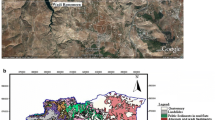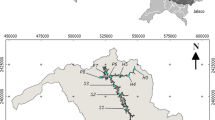Abstract
This paper focuses on characterizing the current status of physiochemical properties of Mujib Dam sediments. Five types of granulometric textural facies were observed for the bottom sediments of Mujib reservoir bed; these are clayey facies, clayey-silt facies, sand-silt-clay facies, sand facies, and granule facies. This average grain size will likely play a vital role in adsorption-desorption of the majority trace metals to the reservoir lake. Other sediment parameters including the total averages were 5.9% (total organic matter (TOM)), 7.5 (pH), 25.8% (CaCO3), and 88.0 meq/100 g (cation exchange capacity), with dominant mineralogical constituents of quartz, calcite, dolomite, and minor feldspar and with variability in clay mineral types. The vast majority of trace metals in sediment exhibited values in the range or near the upper limit of the normal worldwide soil ranges. TOM and grain size of sediment are major factors governing the trace metal concentrations. The calculated geoaccumulation index (I geo) and enrichment factor (EF) of metals in sediments of Mujib Dam were ranked as follows: cadmium (Cd) > copper (Cu) > zinc (Zn) > lead (Pb) > cobalt (Co) > iron (Fe) > chromium (Cr) > nickel (Ni) > manganese (Mn) > Sr based on the I geo and Cd > Zn > Pb > Co > Cr > Cu > Sr > Ni > Mn according to the EF values. The estimated percentage loss in volumetric capacity of the reservoir due to sedimentation was 1.55% per year, indicating that the sediment currently occupied 18.63% of the original reservoir storage capacity. The maximum life span of reservoir is about 64.46 years.










Similar content being viewed by others
References
Abrahim, G. M. S., & Parker, R. J. (2008). Assessment of heavy metal enrichment factors and the degree of contamination in marine sediments from Tamaki Estuary, Auckland, New Zealand. Environmental Monitoring and Assessment, 136, 227–238.
Al-Malahmeh, M. (2006). Quality of treated wastewater produced from Al-Lajoum wastewater treatment plant. M.Sc. thesis, M’tah University, Jordan, 154P.
Al-Rousan, S., Al-Taani, A. A., & Rashdan, M. (2016). Effects of pollution on the geochemical properties of marine sediments across the fringing reef of Aqaba, Red Sea. Marine Pollution Bulletin, 110(1), 546–554.
Al-Taani, A. A., Batayneh, A., Nazzal, Y., Ghrefat, H., Elawadi, E., & Zaman, H. (2014). Status of trace metals in surface seawater of the Gulf of Aqaba, Saudi Arabia. Marine Pollution Bulletin, 86(1–2), 582–590.
Al-Taani, A. A., Batayneh, A., El-Radaideh, N., Al-Rawabdeh, M., Al-Momani, T., & Taani, A. (2015a). Spatial distribution and pollution assessment of heavy metals in surface sediments of Ziqlab Reservoir, Jordan. Environmental Monitoring and Assessment, 187, 1–14. doi:10.1007/s10661-015-4289-9.
Al-Taani, A. A., Rashdan, M., & Khashashneh, S. (2015b). Atmospheric dry deposition of mineral dust to the gulf of Aqaba, red sea: Rate and trace elements. Marine Pollution Bulletin, 92(1–2), 252–258.
Annandale, G.W. (2001). Reservoir conservation and sediment management.
ANZECC & ARMCAZ, (2000). Sediment quality guidelines (in) Australian and New Zealand guidelines for fresh and marine water quality.
Batayneh, A., Ghrefat, H., Zumlot, T., Elawadi, E., Mogren, S., Zaman, Z., Al-Taani, A. A., Nazzal, Y., & Elwaheidi, M. (2015). Assessing of metals and metalloids in surface sediments along the gulf of Aqaba Coast, Northwestern Saudi Arabia. Journal of Coastal Research, 31(1), 163–176.
Bender F., 1974. Geology of Jordan, Borntraeger Berlin 170 pp.
Canfield, D. E., & Bachmann, R. W. (1981). Prediction of total phosphorus concentrations, chlorophyll-alpha, and secchi depths in natural and artificial lakes. Journal of Fish Aquatic Science, 38, 414–423.
Cottenie, A. (1980). Soil and plant testing as a basis of fertilizer recommendations. Food and Agriculture Organization of the United Nations; Soil Resources, Management and Conservation Service Land and Water Development Division. FAO Soils Bulletin, 38(2), 7–93.
Donahue, R. L., Miller, R. W., & Schickluna, J. C. (1983). An introduction to soils and plant growth, In: J. Miller, 5th Edition: Prentice-Hall Inc (p. 667). New Jersey: Englewood Cliffs.
El-Radaideh, N. (2016). Geoenvironmental assessment of Al-Wala Reservoir sediments, Jordan. Geosciences Journal. doi:10.1007/s12303-015-0022-5.
El-Radaideh, N., Al-Taani, A. A., Al-Momani, T., Tarawneh, K., Batayneh, A., & Taani, A. (2014). Evaluating the potential of sediments in Ziqlab Reservoir (northwest Jordan) for soil replacement and amendment. Lake and Reservoir Management, 30, 32–45. doi:10.1080/10402381.2013.870263.
El-Radaideh, N., Al-Taani, A. A., & Al Khateeb, W. (2017). Status of Sedimentation in King Talal Dam, Case study from Jordan. Environmental Earth Sciences, 76(132), 1–14.
Ergin, M., Saydam, C., Basturk, O., Erdem, E., & Yoruk, R. (1991). Heavy metal concentrations in surface sediments from the two coastal inlets (Golden Horn Estuary and Izmit Bay) of the northeastern Sea of Marmara. ChemicalGeology, 91, 269–285.
Fonseca, R., Barriga, F. J. A. S., & Fyfe, W. S. (1993). Suitability for agricultural use of sediments from the Maranhão reservoir, Portugal. In Optimization of plant nutrition (pp. 665–671). Netherlands: Springer. doi:10.1007/978-94-017-2496-8-103.
Fonseca, R., Barriga, S., & Fyfe, W., 2003, Dam reservoir sediments as fertilizers and artificial soils: case studies from Portugal and Brazil. Proceedings of the International Symposium of the Kanazawa University 21st-Century COE Program on Water and Soil Environments, Biological and Geological Perspectives, Kanazawa, March 17–18, p. 55–62.
Fonseca, R., Canario, T., Morais, M., & Barriga, F. (2011). Phosphorus sequestration in Fe-rich sediments from two Brazilian tropical reservoirs. Applied Geochemistry, 26, 16–27. doi:10.1016/j.apgeochem.2011.04.017.
Forstner, U., & Wittmann, G. T. W.(1983). Metal pollution in the aquatic environment: New York, Springer-Verlag, 486 p.
Fortescue, J. (1992). Landscape geochemistry—retrospect and prospect—1990. Applied Geochemistry, 7, 1–54. doi:10.1016/0883-2927 (92)90012-R.
Fraterrigo, J. M., & Downing, J. A. (2008). The influence of land use on lake nutrients varies with watershed transport capacity. Ecosystems, 11(7), 1021–1034. doi:10.1007/s10021-008-9176-6.
Gowd, S. S., Reddy, M. R., & Govil, P. K. (2010). Assessment of heavy metal contamination in soils at Jajmau (Kanpur) and Unnao industrial areas of the Ganga Plain, Uttar Pradesh, India. Journal of Hazardous Materials, 174, 113–121.
Hailat, I. A., & Manasreh, W. A. (2008). The study of the influence of Al-Lajoun basin on water quality of Al-Mujib Dam, Department of chemistry, Mutah University, Al-Karak-Jordan.
Hesse, P. R. (1972). Textbook of soil chemical analysis (p. 520) . New York: Chemical Publications. http://www.mincos.gov.au/publications/australian_and_new_zealand_guidelines_for_fresh_and_marine_water_quality
Ijam, A. Z., & Al-Mahamid, M. (2012). Predicting sedimentation at Mujib Dam Reservoir in Jordan. Jordan Journal of Civil Engineering, 6(4), 448–463.
JICA Expert/Sabo & Landslide Technical Center. (2013). Japan. Akihiko IKEDA: Sediment countermeasures for dams reservoir.
Jiries, A. G. (2001). Chemical evaluation of treated sewage effluent in Karak Province and its suitability for irrigation purposes. Pakistan Journal of Biological Science., 4, 1400–1402.
Kabata-Pendias, A. (2011). Trace elements in soils and plants (4th ed.). Boca-Raton: CRC Press.
Loring, D. H., & Rantala, R. T. (1992). Manual for the geochemical analysis of marine sediments and suspended particulate matter. In Earth science reviews (Vol. 32, pp. 235–263). Amsterdam: Elsevier.
MacDonald, D. D., Ingersoll, C. G., & Berger, T. A. (2000). Development and evaluation of consensus-based sediment quality guidelines for freshwater ecosystems. Archives of Environmental. Contaminant. Toxicology., 39, 20–31.
Mahmood, K. (1987). Reservoir sedimentation: impact, extent, and mitigation. World Bank Technical Paper No. 71, World Bank, Washington, DC.
Maiti, S. K. (2003). Handbook of methods in environmental studies: air, noise, soil and overburden analysis. ABD Publishers.Vol. 2
Manasreh, W., Hailat, I., & El-Hasan, T. (2010). Heavy metal and anionic contamination in the water and sediments in Mujib reservoir. Central Jordan, Environmental Earth Sciences, 60, 613–621.
Margane, A., Subah, A., Hajali, Z., & Almomani, Th. (2008). Delineation of surface water protection zones for the Mujb Dam, Technical Cooperation Project Groundwater Resources Management Technical Report No. 10, Amman, Prepared by BGR and MWI, BGR Archive No. 2005.2110.4.
Moura, C. L., & Sigolo, J. B. (2002). Heavy metals concentration (Cr, Cu, Ni and Zn) in bottom sediments of the Embu-Mirim River, Sp. In Anais da Academia Brasileira de Ciencias, 74 (3). Rio de: Janeiro.
Mucha, A. P., Vasconcelos, M. T. S. D., & Bordalo, A. A. (2003). Macrobenthic community in theDouro Estuary: relations with trace metals and natural sediment characteristics. Environmental Pollution., 121, 169–180.
Mukai, H., Tanaka, A., Fujii, T., & Nakao, M. (1994). Lead isotope ratios of airborne particulate matter as tracers of long-range transport of air pollutants around Japan. Journal of Geophysics Research, 99, 3717–3726.
Muller, G. (1981). Die Schwermetallbelastung der Sedimenten des Neckars und Seiner Nebenflu¨sse. Chemiker-Zeitung, 6, 157–164.
NWMP (National Water Master Plan (NWMP). (2004). Surface water resources: vol(4). Open files: Ministry of Water and Irrigation, Jordan and German Technical Cooperation (GTZ).
Plumb, R. H., Jr. (1981). Procedure for handling and chemical analysis of sediment and water samples. Prepared by Great Lakes Laboratory, State University College at Buffalo, NY, for the US Environmental Protection Agency /US Army Corps of Engineers Technical Committee on Criteria for Dredged and Fill Material. Vicksburg (MS): US Army Engineer Waterways Experiment Station. Tech. Rep. EPA/CE-81–1.
Salman, A., Al-Qinna, M., & Al Kuisi, M. (2014). Spatial analysis of soil and shallow groundwater physicochemical parameters in El-Mujib Basin-central Jordan. Journal of Asian Earth Sciences, 79, 366–381.
Salt, D. E., Blaylock, M., & Kumar, N. P. B. (1995). Phytoremediation: a novel strategy for the removal of toxic metals from the environment using plant. Biotechnology, 13, 468–474.
Shacklette, H. T., & Boerngen, J. G. (1984). Element concentrations in soils and other surficial materials of the conterminous United States. U.S. Geology. Survey Professional Paper 1270.
Shepard, F. P. (1954). Nomenclature based on sand-silt-clay ratios. Journal of Sediment Petrology, 24, 151–158.
Sparks, D. L. (2002). Environmental soil chemistry (p. 345). San Diego: Academic Press.
Sutherland, R. A. (2000). Bed sediment-associated trace metals in an urban stream, Oahu, Hawaii. Environmental Geology, 39, 611–627.
Turekian, K., & Wedepohl, K. H. (1961). Distribution of the elements in some major units of the earth’s crust. Geological Society of America Journal, 72, 175–192.
Williams, T. M., Rees, J. G., & Setiapermana, D. (2000). Metals and trace organic compounds in sediments and waters of Jakarta Bay and the Pulau Seribu Complex, Indonesia. Marine Pollution Bulletin, 40, 277–285.
Yoon, Y. N. (1992). The state and the perspective of the direct sediment removal methods from reservoirs. International Journal of Sediment Research, 7, 99–115.
Yusuf, N., Al-Taani, A. A., Al-Fukaha, F., Al-Shereideh, S., & Mahasneh, M. (2011). Sediments transport across the fringing reef in the gulf of Aqaba, red sea and the implications on live corals. Abhath Al-Yarmouk: Basic Science & Engineering, 20(1), 35–52.
Zhang, J., & Liu, C. L. (2002). Riverine composition and estuarine geochemistry of particulate metals in China—weathering features anthropogenic impact and chemical fluxes. Estuarine, Coastal and Shelf Science, 54, 1051–1070.
Zheng, N., Wang, Q., Liang, Z., & Zheng, D. (2008). Characterization of heavy metal concentrations in the sediments of three freshwater rivers in Huludao City, Northeast China. Environmental Pollution, 154, 135–142.
Acknowledgments
The authors would like to extend their sincere appreciation to the Scientific Research Support Fund at Amman, Jordan, for its funding this research, project number WE/2/05/2012. The authors would like to express their sincere gratitude to the Departments of Earth and Environmental Science, Yarmouk University.
Author information
Authors and Affiliations
Corresponding author
Electronic supplementary material
ESM 1
(DOCX 27 kb)
Rights and permissions
About this article
Cite this article
El-Radaideh, N., Al-Taani, A.A. & Al Khateeb, W.M. Characteristics and quality of reservoir sediments, Mujib Dam, Central Jordan, as a case study. Environ Monit Assess 189, 143 (2017). https://doi.org/10.1007/s10661-017-5836-3
Received:
Accepted:
Published:
DOI: https://doi.org/10.1007/s10661-017-5836-3




